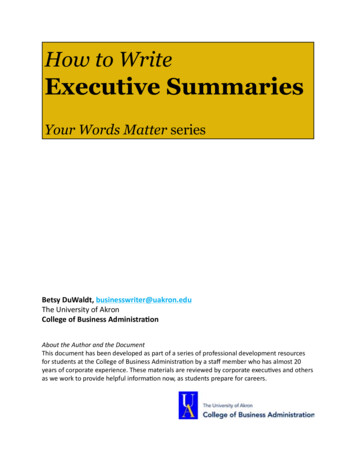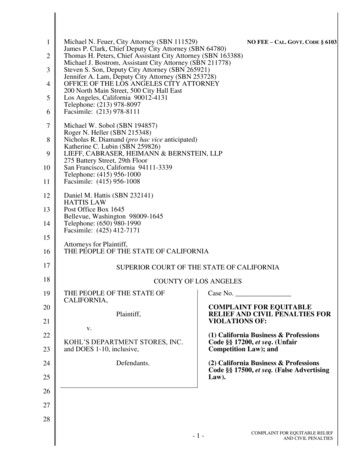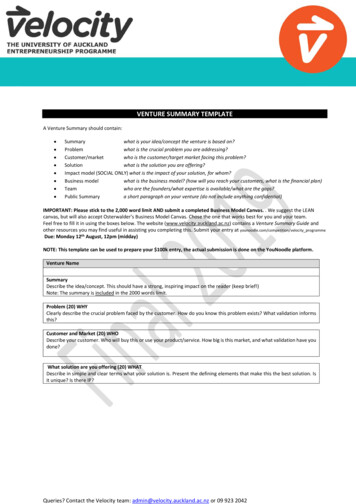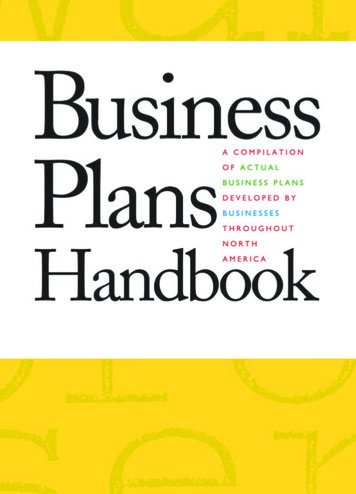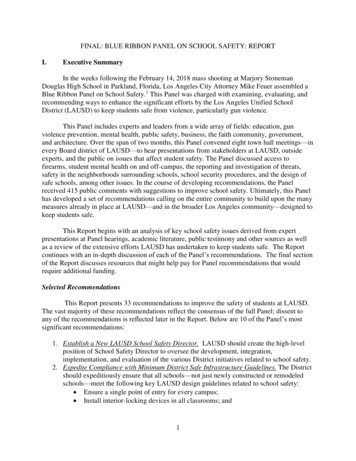
Transcription
FINAL: BLUE RIBBON PANEL ON SCHOOL SAFETY: REPORTI.Executive SummaryIn the weeks following the February 14, 2018 mass shooting at Marjory StonemanDouglas High School in Parkland, Florida, Los Angeles City Attorney Mike Feuer assembled aBlue Ribbon Panel on School Safety.1 This Panel was charged with examining, evaluating, andrecommending ways to enhance the significant efforts by the Los Angeles Unified SchoolDistrict (LAUSD) to keep students safe from violence, particularly gun violence.This Panel includes experts and leaders from a wide array of fields: education, gunviolence prevention, mental health, public safety, business, the faith community, government,and architecture. Over the span of two months, this Panel convened eight town hall meetings—inevery Board district of LAUSD—to hear presentations from stakeholders at LAUSD, outsideexperts, and the public on issues that affect student safety. The Panel discussed access tofirearms, student mental health on and off-campus, the reporting and investigation of threats,safety in the neighborhoods surrounding schools, school security procedures, and the design ofsafe schools, among other issues. In the course of developing recommendations, the Panelreceived 415 public comments with suggestions to improve school safety. Ultimately, this Panelhas developed a set of recommendations calling on the entire community to build upon the manymeasures already in place at LAUSD—and in the broader Los Angeles community—designed tokeep students safe.This Report begins with an analysis of key school safety issues derived from expertpresentations at Panel hearings, academic literature, public testimony and other sources as wellas a review of the extensive efforts LAUSD has undertaken to keep students safe. The Reportcontinues with an in-depth discussion of each of the Panel’s recommendations. The final sectionof the Report discusses resources that might help pay for Panel recommendations that wouldrequire additional funding.Selected RecommendationsThis Report presents 33 recommendations to improve the safety of students at LAUSD.The vast majority of these recommendations reflect the consensus of the full Panel; dissent toany of the recommendations is reflected later in the Report. Below are 10 of the Panel’s mostsignificant recommendations:1. Establish a New LAUSD School Safety Director. LAUSD should create the high-levelposition of School Safety Director to oversee the development, integration,implementation, and evaluation of the various District initiatives related to school safety.2. Expedite Compliance with Minimum District Safe Infrastructure Guidelines. The Districtshould expeditiously ensure that all schools—not just newly constructed or remodeledschools—meet the following key LAUSD design guidelines related to school safety: Ensure a single point of entry for every campus; Install interior-locking devices in all classrooms; and1
Ensure every classroom has a working two-way intercom and publicannouncement system.3. Stress Safe Gun Storage by Parents. LAUSD should require parents to attest that anyfirearms at home are safely stored. In addition, the District, local law enforcementagencies, health agencies, and nonprofits like Women against Gun Violence and MomsDemand Action should collaborate to inform adults of their duty to safely store firearms,including relaying this responsibility in the Student Handbook.4. Dramatically Expand School-Based Mental Health Resources. LAUSD should increasethe number of Psychiatric Social Workers assigned to schools, with the ultimate goal ofmaintaining a full-time PSW on staff at every school.5. Ensure an Adult Connection for Every Student. LAUSD should take measures to ensurethat every student has a meaningful connection with an adult on campus.6. Create a Unified Law Enforcement Approach to Neighborhood School Safety. The LosAngeles County Sheriff’s Department, Los Angeles Police Department (LAPD), LosAngeles School Police Department (LASPD), other local police agencies and prosecutorsshould collaborate to share data about neighborhood crime around school sites to identifyparticularly at-risk schools and develop joint law enforcement strategies.7. Update and Consolidate Systems for Reporting Threats of Violence. LASPD andLAUSD should consolidate their threat reporting efforts in one campaign with multiplemechanisms for reporting and monitoring threats.8. Build Comprehensive Safe Passage to School Program. LAUSD and stakeholdersthroughout the Los Angeles community should collaborate to dramatically enhance safepassages programs and bring these programs to scale throughout the District.9. Develop Age-Appropriate Active Gunfire Response Trainings for Students. LASPDshould work with LAUSD to develop age-appropriate, trauma-informed active gunfireresponse trainings or discussions for students.10. Increase Cross-Jurisdictional Mental Health Collaboration. LAUSD and stakeholdersthroughout Los Angeles should expand on existing partnerships to provide mental healthservices for students—for example, by advocating together for increased state fundingand streamlining municipal grant applications.A Word about ResourcesThis Panel is aware that it will take significant investment from multiple stakeholdersthroughout Los Angeles to realize these recommendations. LAUSD is the second largest schooldistrict in the nation, enrolling more than 640,000 K-12 students in approximately 1100 schoolsspread out over 720 square miles.2 California ranks among the lowest in the United States in perpupil spending,3 and thus LAUSD struggles with severe resource constraints. However, thisPanel—through the coordination of the Los Angeles City Attorney’s Office—has already begunbuilding partnerships to direct existing resources toward realizing these school safetyrecommendations. This Panel will continue to pursue resources to implement therecommendations contained in this Report.With respect to funding, the Panel recommends that:2
II.The business community should collaborate to develop a large-scale adopt-a-schoolprogram;The philanthropic community—segments of which already are coordinating efforts tofund district priorities—should provide funding for school safety projects;LAUSD and its public partners should pursue federal and state grants to supportschool safety efforts;LAUSD should pursue supplemental state funding to enhance school safety;LAUSD should pursue an allocation of already-approved state bonds for capitalimprovements to enhance school safety;LAUSD should advocate to include school safety provisions in a potential 2020 stateschool bond measure; andLAUSD should include key Panel recommendations on school safety in its planningfor a local parcel tax or other locally-approved funding.Background on School Safety in the United States and within LAUSDSchool shootings have become an all-too-frequent occurrence in modern America. Fromthe 2012 shooting at Sandy Hook Elementary School that claimed the lives of 20 first-graders tothe present, the Gun Violence Archive has counted 251 shootings at K-12 schools in the UnitedStates.4 In that time, over 350 people have been shot; 120 have died.5To make recommendations that could meaningfully improve school safety, this Panel hadto understand why school shootings have been able to occur so frequently in the United States.The Panel quickly learned that there is no single “profile” of a school attacker, and relying ondemographics alone to predict potential school shooters would likely be both over-inclusive andunder-inclusive.6 Instead, research shows commonalities among school shootings that can informresponsive and preventative measures to increase school safety. Informed by national casestudies as well as presentations from experts, the Panel learned that mass shootings are related toa variety of interconnected factors—not only at the school site, but also in surroundingcommunities. Thus, this Panel broadened its approach to understand how all of these factorsaffect student safety.This section highlights six research-based observations regarding school safety. Thissection additionally discusses the measures currently taken at LAUSD and in the Los Angelescommunity to address each school safety concern.Observation #1: Many school attackers struggle with stressors to their mental or emotionalhealth—stemming from peer victimization, personal loss, and trauma—and cope with thesestressors through violence.Researchers have identified a common theme among case studies of school attacks: Inmost cases, the perpetrators grappled with stressors to their mental or emotional health anddisplayed symptoms suggesting they could not cope with these stressors. According to the SecretService’s and Department of Education’s Safe Schools Initiative Final Report, nearly threequarters of school shooters (71%) felt persecuted or bullied at school.7 This victimization bypeers led perpetrators to feel isolated and marginalized at school prior to the attack. Further3
aggravating the sense of peer victimization, nearly all school shooters (98%) experienced orperceived some sort of major personal loss or failure—ranging from loss of social status to lossof a relationship—prior to their attack.8 In part as a result of these feelings of victimization andpersonal loss, 81% of school shooters held a specific grievance against someone at the time ofthe attack, and revenge was a motive for 61% of school shootings.9While many students struggle with stressors to their mental and emotional health, the vastmajority do not resort to violence at school. The small number of students who respond to suchstressors with violence lack the capacity to cope in healthy ways.10 School attackers havecommonly exhibited “poor control of anger, lack of empathy, and a combined sense ofpersecution, righteous indignation, and superiority” that made them particularly unable to copewith peer victimization or personal loss.11 This inability to cope was often apparent prior to aschool attack: 78% of school shooters had a history of suicide attempts or suicidal ideation, and83% of school shooters had shown signs that they were not coping well, such as depression.12Though the majority of students who struggle with mental and emotional health issues donot attack their schools, the majority of school attackers have struggled with mental andemotional health issues. Thus, it is important to understand how stressors can affect youthbehavior and development.Effects of Toxic Stress on the BrainMany children have undergone deeply upsetting experiences that can threaten healthybrain and behavioral development. In surveys by the Centers for Disease Control and Prevention,over 20% of adults responded that they had at least one Adverse Childhood Experience (ACE)—experiences indicative of childhood abuse or household dysfunction.13 National studies haveestimated that each year over 10 million children witness physical aggression between theirparents and that more than 90% of children witness violence in their community at some point intheir childhood.14 More than one fifth of children live in families with incomes below the federalpoverty threshold.15Any of these experiences can cause children to experience “toxic stress,” which changestheir brains on a cellular level.16 When a child experiences “toxic stress,” the child’s stressresponse stays permanently on high alert—even after the original event has passed and laterwhen there is no apparent threat at all.17 This causes children’s stress systems to become overactivated at the direct expense of the parts of the brain related to impulse control, reasoning, andlearning.18 In these situations, children’s stress response systems transitions from adaptive, orlife-saving, to maladaptive, or health-damaging.19 Children exposed to toxic stress are thus morelikely to experience symptoms of anxiety, depression, and even post-traumatic stress disorder(PTSD).20 Additionally, these children are more likely to exhibit negative behaviors inadolescence—including dropping out of school, drug use, attempted suicide21—as well asaggressive or violent behavior.22Prevalence of Mental and Emotional Health Stressors at School4
Millions of students come to school each day suffering from mental health issues.23National studies estimate that up to one in five children in the United States show signs orsymptoms of a mental health disorder each year.24 Over 30% of urban youth show signs orsymptoms of PTSD.25While many of these mental health issues originate off-campus, they can be aggravatedby dynamics at school. Bullying in schools can contribute to students feeling unsafe anddeveloping mental health issues—and in some cases may lead to violent attempts to respond.One recent national survey has found that approximately 28% of middle school and high schoolstudents reported being bullied during the school year.26 Victims of bullying experience higherthan average rates of mental health issues such as anxiety or depression, physical healthproblems, and social development difficulties such as withdrawal or tendencies towardviolence.27Schools can play a vital role in curbing negative dynamics on-campus as well asproviding children with access to mental health services. By promoting a positive school climatethat engages students in learning and inspires them to feel invested in each other, schools cansignificantly reduce instances of bullying.28 Additionally, schools often provide the only sourceof mental health services that children can access: 75% of children who receive mental servicesaccess this care in a school setting.29 For this reason, the School Social Work Association ofAmerica recommends one psychiatric social worker for every 250 students.30Still, nearly 80% of the children who need mental health services do not receive them.31It is estimated that in U.S. public schools, there is on average one school mental healthprofessional for every 482 students.32 Experts have advised that students’ mental health andwellbeing will not be improved unless schools incorporate more school-based mental healthpersonnel.33LAUSD’s Resources for Students’ Mental and Emotional HealthStakeholders at LAUSD report that there is a high need for mental and emotional healthservices at LAUSD.34 A recent screening of 8000 LAUSD students found that 26% are at highrisk for traumatic stress.35 Additionally, of the 48,000 LAUSD students surveyed in 2017, 19%reported that they had been bullied in the past year.36Currently, LAUSD provides four main programs that address student mental andemotional health at its 1100 K-12 schools. First, LAUSD Student Health and Human Services(SHHS) School Mental Health retains psychiatric social workers (PSWs), trained in evidencebased and trauma-informed practices. Individual schools can hire these PSWs part-time or fulltime, depending on individual schools’ funding priorities given severe budget constraints.37 Forthe 2018-19 school year, 245 schools have hired 174 school-based PSWs.38 Second, inpartnership with the Los Angeles County Department of Mental Health, 66 PSWs from LAUSDSchool Mental Health provide services at wellness centers and stand-alone mental health clinicsacross the District.39 Third, 53 PSWs provide special education services where students canreceive weekly consultations.40 Fourth, LAUSD School Mental Health trains individual schoolsto convene threat-assessment teams for students who present an immediate harm to themselves5
or others.41 LAUSD School Mental Health also presides over a district-wide team comprisingrepresentatives from multiple city and state agencies—including LASPD, DCFS, and the LosAngeles City Attorney’s Office—to conduct an in-depth threat assessment for two severesuicidal/homicidal cases each month.42 In the aggregate, 410 PSWs and administrators at SchoolMental Health provide services for 640,000 K-12 students at 1100 schools—this amounts toapproximately 1 PSW for every 1600 students.43While PSWs are the primary source of mental health services for LAUSD, otherpersonnel also provide services related to mental health. Pupil Services and AttendanceCounselors (PSAs) work with students with poor attendance records to address the underlyingcauses of students’ truancy, often mental or emotional health issues.44 Student Support Servicesalso provides academic support tutors districtwide as well as PSAs for specific at-riskpopulations, such as foster youth.45 Restorative Justice Advisers help school personnel engage inbest practices for conflict resolution.46 Finally, school nurses address a range of student physicaland mental health needs.47 Overall, counting all LAUSD personnel who provide services relatingto student mental health—including PSWs—LAUSD maintains 1 such professional for every500 students.48 Also helping these professionals provide student mental health services are over300 undergraduate and graduate students from at least eight universities.49In addition to its student-focused mental health services, LAUSD has undertaken effortsto improve school climate by fostering positive relationship building. LAUSD is currently ontrack to implement restorative justice initiatives in all K-12 schools by 2020.50 Restorativejustice practices provide relationship-building alternatives to traditional discipline.51 Sincetransitioning to restorative justice initiatives, LAUSD’s suspension rate has dropped from 8% to.55%.52 In addition to restorative justice trainings, SHHS trains all LAUSD personnel twiceannually to incorporate social emotional learning to reduce bullying.53 However, LAUSD doesnot require all classrooms to dedicate time to social emotional learning, and thus manyclassrooms do not.54 Overall, some teachers have felt that they have received inadequate trainingin new classroom management and discipline methods.55Observation #2: Easy access to firearms, especially in the home, gives school attackers thecapacity to commit lethal violence.Even if troubled individuals had thoughts or vague plans to commit violence at school,they could not carry out a school shooting without a firearm. In the vast majority of activeshooter case studies, the shooter used a weapon that had been lawfully obtained by its owner.56Nearly 70% of student shooters—who as minors cannot purchase a gun—gained access to alawfully purchased weapon from their home or the home of a relative.57 Parents may think thatchildren cannot gain access to firearms stored in the home, but studies have shown that parents’beliefs are mistaken. 87% of children knew where their parents’ firearms were kept, and 60%had handled their parents’ firearms.58 Easy access to a weapon in the home allows troubledstudents to act on their violent thoughts. Thus in order to prevent troubled students from gainingaccess from a weapon, it is important—and, in Los Angeles, legally-required— for adults tostore their weapons responsibly.Gun Storage Laws in Los Angeles and California6
California law generally prohibits any person from selling, loaning, or giving a firearm toa minor or a handgun to someone below the age of twenty-one.59 Anyone who furnishes afirearm to a minor or handgun to someone under twenty-one can be punished by imprisonmentof up to one year in county jail or subject to a fine of up to 1000.60State and local law also criminalizes unsafe storage of firearms where minors may bepresent. Under California law, adults can be liable for criminal storage of a firearm when theykeep a loaded firearm on their property in a location where they should reasonably know a minorcould access the firearm without permission.61 If a minor does, in fact, gain access to thatimproperly stored firearm, the adult can be punished by up to three years imprisonment or a 10,000 fine, depending on the damage the minor causes.62 Even if a minor does not gain accessto the firearm, an adult can be liable under state law for negligent storage of a firearm.63 The LosAngeles Municipal Code additionally imposes misdemeanor liability on any adult who does notkeep a handgun (loaded or unloaded) stored in a locked container or disabled by an approvedtrigger lock.64 Not only can adults be criminally prosecuted under state or local law, but adultscan be civilly liable under state law up to 60,000 if they provide a firearm to a minor ornegligently store a firearm and the minor causes damage.65 However, unsafe storage violationsare not firearm prohibiting offenses; thus, an adult convicted of unsafely storing a firearm whereminors are present may still lawfully possess a firearm in California.66Efforts to Educate LAUSD Parents about Gun Storage Duties and Enforce Gun Storage LawsApproximately 20% of adults in California possess a firearm.67 While gun stores arerequired to post fliers that set forth safe storage requirements, there are no dedicated resourcesfor educating adults about safe storage of firearms.68 Currently, LAUSD does not provideinformation in its student handbook or online about parents’ legal duties to safely storefirearms.69 Because of this, some nonprofit organizations have taken initiative to educate parentsabout safe firearm storage. Women against Gun Violence (WAGV) offers the TALK Project, apresentation on the risks and benefits of owning a gun in a home with children as well as parents’legal obligations to store firearms safely.70 WAGV has received permission from LAUSD tosend one-page informational fliers to parents, but school officials have been reluctant to allowTALK Project trainings, citing their possibly upsetting nature or the political issues that might beassociated with them.71 Moms Demand Action (MDA) similarly offers the Be SMARTcampaign, emphasizing five steps for responsible gun ownership in homes with minors.72However, like WAGV, MDA has encountered pushback from schools that object to sendinghome information on safe storage because this information could be controversial.73In addition to educating adults on safe gun storage laws, law enforcement officials haveincreasingly held adults accountable for allowing children to gain access to unsafely storedfirearms.74 Since 2013, the Los Angeles City Attorney’s Office has collaborated with LAPD andLASPD to criminally prosecute adults who have unlawfully stored firearms in residences whereminors are present.75 Of the dozen criminal gun storage cases the Los Angeles City Attorney’sOffice has prosecuted since 2017, approximately two-thirds were referred to the Los AngelesCity Attorney’s Office after a student had made a threat of school violence.767
Observation #3: In many cases, a third-party knew about a school attacker’s plan to somedegree, yet felt discouraged from reporting the threat to adults who could investigate.The majority of school attacks were premeditated.77 In 81% of school shootings, at leastone person, usually a peer, had information that the shooter was considering or planning theschool attack—ranging from knowing the shooter’s exact plans to simply knowing thatsomething “bad” was about to happen.78 Because the vast majority of attackers share their planswith at least one peer, these peers are a crucial source of information to prevent violence. Whenthreats to school have been successfully thwarted, “[t]he most common method [for averting aschool attack] was other students coming forward to inform school or police officials.”79Yet, many students do not come forward with information about potential threats becausethey adhere to “codes of silence,” unspoken agreements among students not to “snitch” or“tattle” on each other to adults.80 Schools can break down codes of silence by creating a culturewhere students feel comfortable coming forward with information on school threats.81 Studentsare more likely to break through codes of silence when a school builds a democratic authoritystructure—where students feel respected and trust adults to fairly intervene—and when studentsfeel a sense of personal belonging at the school.82Channels for Reporting Threats to LAUSDTips about potential threats to school safety come to LASPD from members of the publicand through partner law enforcement agencies.83 To field threats from the public, LASPDadvertises three 24-hour hotlines: the LASPD Weapons Hotline and two general crimes hotlinesrun by private organizations that refer tips to law enforcement.84 Of the three listed hotlines, onlythe LASPD Weapons Hotline is focused entirely on school safety. These numbers are notfeatured on LAUSD’s webpages or LAPD’s webpage for “Non-Emergency Crime Reporting &Hotlines.”85 Because these numbers are not widely advertised, many parents, students, and othermembers of the LAUSD community are unaware of these channels for reporting threats.86However, LAUSD and LASPD have begun a “See Something, Say Something” campaign todestigmatize threat reporting and publicize these hotlines.87LASPD also receives information about threats to schools through the Joint RegionalIntelligence Center (JRIC), a partnership between federal, state, and local law enforcementagencies covering Los Angeles, San Bernardino, Riverside, San Luis Obispo, Santa Barbara, andVentura counties.88 JRIC maintains a single tracking log for all school threats received by lawenforcement.89 Every morning, LASPD checks this tracking log to evaluate threats before schoolstarts.90 Partnering with JRIC allows LASPD to collaborate with partner law enforcementagencies to ensure that all threats have been investigated.91Procedures for Investigating Threats to LAUSDWhen LASPD receives information about a potential violent threat involving a school orother LAUSD property, LASPD evaluates the specificity and context of the information to weighthe severity, credibility, and viability of the threat.92 LASPD’s detectives investigate crediblethreats in real time and have full authority to serve search or arrest warrants.93 LASPD refers8
viable criminal cases to the Los Angeles District Attorney as well as City Attorneys withinLAUSD’s boundaries to evaluate for potential criminal prosecution.94 However, because underCalifornia law criminal threats must be made with a high level of specificity against anindividual or group of individuals—rather than a location—and in unconditional, immediate, andunequivocal terms, not all mass threats against schools themselves that LASPD has referred toprosecutors have resulted in criminal charges being filed.95Observation #4: On-campus security procedures can contribute to school safety, but can alsodetract from school climate.Preventative measures—involving mental health, access to firearms, and threatreporting—will not thwart every school shooting. As school shootings became more prevalentand publicized in the 1980s and 1990s, schools began to adopt security measures that “hardened”school campuses. Such measures included retaining armed police officers on campus,incorporating metal detector searches, and other similar measures.96 Empirical research on theeffectiveness of such measures has largely yielded mixed results: Some examinations haveshown no correlation between such security measures and school safety while others have shownslightly positive or negative relationships between these measures and school safety.97 Anecdoteshave similarly highlighted both the strengths and weaknesses of school security measures. 98However, security measures have affected perceptions of safety, generally making administrators(and parents) feel that their schools are safer while students are more likely to perceive theirschools as less safe and more prone to disorder.99Los Angeles School Police Presence at LAUSDThe Los Angeles School Police Department is the largest independent school policedepartment in the United States.100 LASPD has 542 personnel serving LAUSD schools: 390sworn officers and 110 school safety officers (SSOs), who are civilian non-armed LASPDemployees.101 At least one sworn LASPD officer is present at every LAUSD high school, andmost middle schools have a sworn LASPD officer or SSO present.102 Elementary schools aresupported by patrolling officers who are responsible for an average of fifteen square miles perofficer.103LASPD conceives its role as both security-based and supportive.104 To ensure schoolsecurity, LASPD partners with the LAUSD Division of District Operations to promulgate safetybulletins and help schools develop integrated safe school plans.105 LASPD also providestrainings for school personnel, though not for students, on responding to incidents involvingactive gunfire.106 When a school initiates a lockdown, LASPD coordinates with the school’sIncident Commander and local police agencies to direct the response and course of action.107 Inits supportive role, LASPD offers student mentorship programs, such as the Police AcademyMagnet Program for students interested in police work as well as the Explorers Program forstudents interested in government studies.108 LASPD also partners with LAUSD’s School Healthand Human Services Department to help execute threat assessments and implement restorativejustice initiatives.109Random Metal Detector Search Policy at LAUSD9
LAUSD requires all middle and high schools to conduct daily random searches ofstudents and lockers with hand-held metal detector wands in order to detect and seize weaponsbrought to school unlawfully.110 Schools with over 1000 students enrolled must have four metaldetector wands used daily while schools with less than 1000 students need only have two useddaily.111Administrators, rather than LASPD officers, are tasked with carrying out thesessearches.112 LAUSD requires administrators to use an unbiased pattern for randomly selectingstudents and student lockers; administrators are prohibited from profiling students for searchesbased on gender, race, ethnicity, or other traits.113 Metal detector searches can also be carried outbased on reasonable suspicion—for example, if administrators receive a tip about a specif
FINAL: BLUE RIBBON PANEL ON SCHOOL SAFETY: REPORT I. Executive Summary In the weeks following the February 14, 2018 mass shooting at Marjory Stoneman Douglas High School in Parkland, Florida, Los Angeles City Attorney Mike Feuer assembled a Blue Ribbon Panel on School Safety.1 This Panel was charged with examining, evaluating, and
